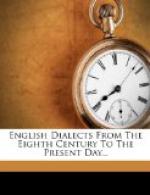The literal meaning of the lines is as follows:
1. God almighty stripped Himself
when He would mount upon the gallows
(the cross),
courageous before all men; I (the
cross) durst not bow down
2. I (the cross) reared up the royal King,
the Lord of heaven; I durst not
bend down.
men reviled us two (the cross and
Christ) both together.
I was moistened with the blood poured
forth from His side.
3. Christ was upon the cross;
howbeit, thither came eagerly from
afar
princes to (see) that One; I beheld
all that.
sorely was I afflicted with sorrows;
I submitted however to the men’s
hands.
4. wounded with arrows,
they laid Him down, weary in His
limbs.
they stood beside Him, at the head
of His corpse.
they beheld there the Lord of heaven.
In the late MS. it is the cross that is wounded by arrows; whereas in the runic inscription it seems to be implied that it was Christ Himself that was so wounded. The allusion is in any case very obscure; but the latter notion makes the better sense, and is capable of being explained by the Norse legend of Balder, who was frequently shot at by the other gods in sport, as he was supposed to be invulnerable; but he was slain thus one day by a shaft made of mistletoe, which alone had power to harm him.
There is also extant a considerable number of very brief inscriptions, such as that on a column at Bewcastle, in Cumberland; but they contribute little to our knowledge except the forms of proper names. The Liber Vit{ae} of Durham, written in the ninth century, contains between three and four thousand such names, but nothing else.
Coming down to the tenth century, we meet with three valuable documents, all of which are connected with Durham, generally known as the Durham Ritual and the Northumbrian Gospels.
The Durham Ritual was edited for the Surtees Society in 1840 by the Rev. J. Stevenson. The MS. is in the Cathedral library at Durham, and contains three distinct Latin service-books, with Northumbrian glosses in various later hands, besides a number of unglossed Latin additions. A small portion of the MS. has been misplaced by the binder; the Latin prose on pp. 138-145 should follow that on p. 162. Mr Stevenson’s edition exhibits a rather large number of misreadings, most of which (I fear not quite all) are noted in my “Collation of the Durham Ritual” printed in the Philological Society’s Transactions, 1877-9, Appendix II. I give, by way of specimen, a curious passage (at p. 192), which tells us all about the eight pounds of material that went to make up the body of Adam.
aehto pundo of th{ae}m aworden is Adam pund lames of thon Octo pondera de quibus factus est Adam. Pondus limi, inde
aworden is fl{ae}sc pund fyres of thon read is blod
factus est caro; pondus ignis, inde rubeus est sanguis
and
hat
et
calidus;




